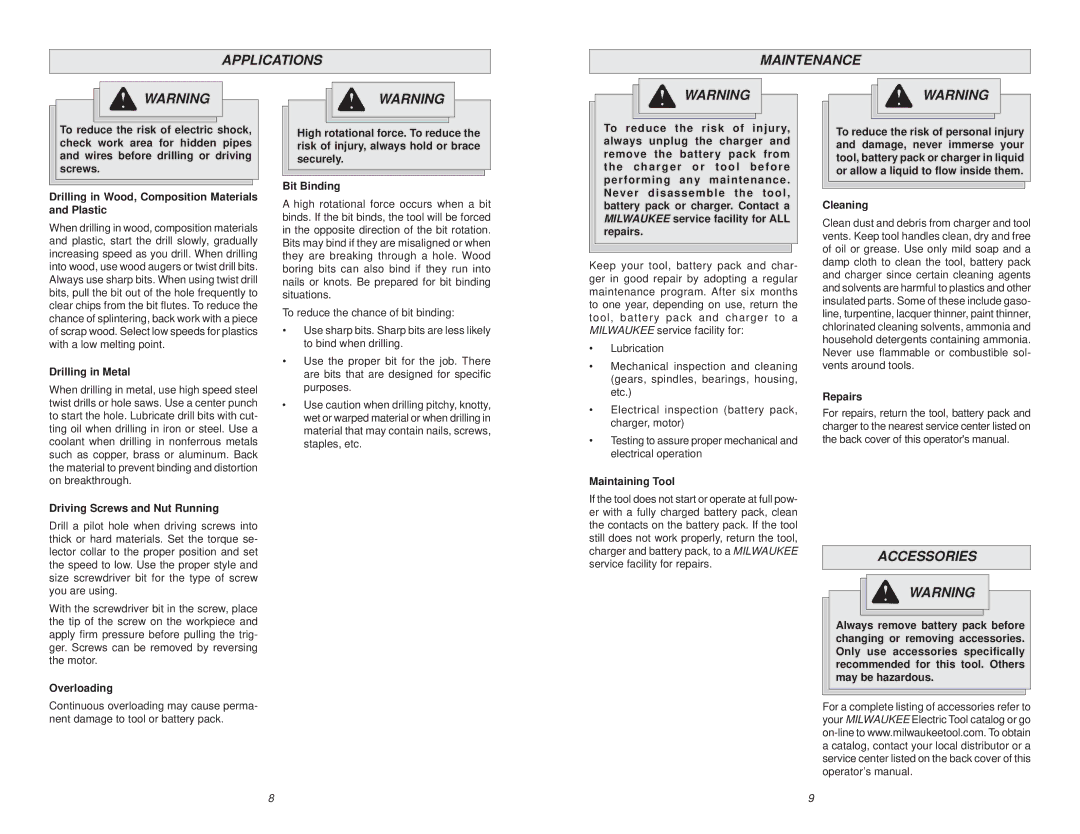
APPLICATIONS
MAINTENANCE
![]() WARNING
WARNING
To reduce the risk of electric shock, check work area for hidden pipes and wires before drilling or driving screws.
Drilling in Wood, Composition Materials and Plastic
When drilling in wood, composition materials and plastic, start the drill slowly, gradually increasing speed as you drill. When drilling into wood, use wood augers or twist drill bits. Always use sharp bits. When using twist drill bits, pull the bit out of the hole frequently to clear chips from the bit flutes. To reduce the chance of splintering, back work with a piece of scrap wood. Select low speeds for plastics with a low melting point.
Drilling in Metal
When drilling in metal, use high speed steel twist drills or hole saws. Use a center punch
WARNING
High rotational force. To reduce the risk of injury, always hold or brace securely.
Bit Binding
A high rotational force occurs when a bit binds. If the bit binds, the tool will be forced in the opposite direction of the bit rotation. Bits may bind if they are misaligned or when they are breaking through a hole. Wood boring bits can also bind if they run into nails or knots. Be prepared for bit binding situations.
To reduce the chance of bit binding:
• | Use sharp bits. Sharp bits are less likely |
| to bind when drilling. |
• | Use the proper bit for the job. There |
| are bits that are designed for specific |
| purposes. |
to start the hole. Lubricate drill bits with cut- ting oil when drilling in iron or steel. Use a coolant when drilling in nonferrous metals such as copper, brass or aluminum. Back the material to prevent binding and distortion on breakthrough.
Driving Screws and Nut Running
Drill a pilot hole when driving screws into thick or hard materials. Set the torque se- lector collar to the proper position and set the speed to low. Use the proper style and size screwdriver bit for the type of screw you are using.
With the screwdriver bit in the screw, place the tip of the screw on the workpiece and apply firm pressure before pulling the trig- ger. Screws can be removed by reversing the motor.
Overloading
Continuous overloading may cause perma- nent damage to tool or battery pack.
• Use caution when drilling pitchy, knotty, |
wet or warped material or when drilling in |
material that may contain nails, screws, |
staples, etc. |
![]() WARNINGWARNING
WARNINGWARNING
To reduce the risk of injury, always unplug the charger and remove the battery pack from the charger or tool before performing any maintenance. Never disassemble the tool, battery pack or charger. Contact a MILWAUKEE service facility for ALL repairs.
To reduce the risk of personal injury and damage, never immerse your tool, battery pack or charger in liquid or allow a liquid to flow inside them.
Cleaning
Keep your tool, battery pack and char- ger in good repair by adopting a regular maintenance program. After six months to one year, depending on use, return the tool, battery pack and charger to a MILWAUKEE service facility for:
•Lubrication
•Mechanical inspection and cleaning (gears, spindles, bearings, housing, etc.)
Clean dust and debris from charger and tool vents. Keep tool handles clean, dry and free of oil or grease. Use only mild soap and a damp cloth to clean the tool, battery pack and charger since certain cleaning agents and solvents are harmful to plastics and other insulated parts. Some of these include gaso- line, turpentine, lacquer thinner, paint thinner, chlorinated cleaning solvents, ammonia and household detergents containing ammonia. Never use flammable or combustible sol- vents around tools.
Repairs
•Electrical inspection (battery pack, charger, motor)
•Testing to assure proper mechanical and electrical operation
Maintaining Tool
If the tool does not start or operate at full pow- er with a fully charged battery pack, clean the contacts on the battery pack. If the tool still does not work properly, return the tool, charger and battery pack, to a MILWAUKEE service facility for repairs.
For repairs, return the tool, battery pack and charger to the nearest service center listed on the back cover of this operator's manual.
ACCESSORIES
WARNING
Always remove battery pack before changing or removing accessories. Only use accessories specifically recommended for this tool. Others may be hazardous.
For a complete listing of accessories refer to your MILWAUKEE Electric Tool catalog or go
8
9
